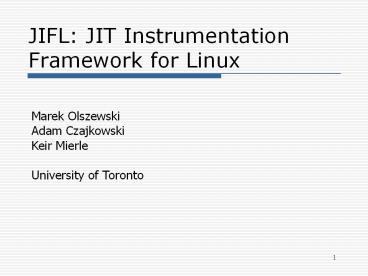JIFL: JIT Instrumentation Framework for Linux - PowerPoint PPT Presentation
Title:
JIFL: JIT Instrumentation Framework for Linux
Description:
... profiling, monitoring, coverage testing, security auditing... by basic block, right before each new basic block is executed. ... Software ... – PowerPoint PPT presentation
Number of Views:33
Avg rating:3.0/5.0
Title: JIFL: JIT Instrumentation Framework for Linux
1
JIFL JIT Instrumentation Framework for Linux
Marek Olszewski Adam Czajkowski Keir
Mierle University of Toronto
2
Instrumenting Operating Systems
- Operating systems are growing in complexity
- Becoming harder to understand
- Kernel instrumentation is a well know method of
combating this problem - Used for debugging, profiling, monitoring,
coverage testing, security auditing... - Dynamic instrumentation is especially useful
- No recompilation no reboot
- Good for debugging systemic problems
- Feasible in production settings
3
Dynamic Instrumentation
- All dynamic instrumentation tools for operating
systems are probe based - Overwrite existing code with jump/trap
instructions - Efficient on fixed length architectures
- Slow on variable length architectures
- Must use trap instruction (and hash table lookup)
- JIT-based instrumentation can be more efficient
- Proven itself for user space (Pin, Valgrind)
- Probe-based instrumentation is seldom used in
user-space
4
Probe-based Instrumentation
Instrumentation Code
Trap Handler
OS Code
- Look up which instrumentation to call
- Call instrumentation
- Emulate overwritten instruction
Instrumentation Code
5
JIT Instrumentation
- JIT instrumentation rewrites the OS code with
calls to instrumentation code - Creates a duplicate instrumented copy of the OS
- Called the code-cache
- Since instrumentation is dynamic, it is not
feasible to rewrite the entire operating system
up-front - Instrumentation is performed just-in-time, basic
block by basic block, right before each new basic
block is executed. - The resulting code is fast
- No hash table lookup required
- Though there is some cost in executing in the
code-cache
6
JIT Instrumentation
Instrumentation Code
Duplicate Copy of OS
OS Code
Instrumentation Code
7
Software Architecture
8
Using JIFL
- Use JIFLs API and build system to easily write
loadable instrumentation plugins - Start by implementing four key functions
- plugin_init
- plugin_exit
- plugin_start
- plugin_stop
- Load/Unload plugin with Linuxs insmod/rmmod
tools - Start/Stop instrumentation with the JIFL starter
tool
9
Example Plugin
include "jifl.h" syscall_t syscall long long
count // Executed for every instrumented basic
block static void inc_count(long long
counter_ptr, long size) counter_ptr
size // Called for every newly discovered
basic block static void bb_inst(bb_t bb, void
arg) long bb_size bb_size(bb)
bb_insertcall(bb, inc_count, ARG_VOID_PTR,
count, ARG_INT32, bb_size, ARG_END) // Start
instrumentation of clone system call static void
plugin_start() syscall_init(syscall,
__NR_clone) Syscall_add_bb_instrumentation(s
yscall, bb_inst, NULL) syscall_start_instrume
nting(syscall) // Stop instrumentation of
clone system call static void plugin_stop()
syscall_stop_instrumenting(syscall)
printk("Clone system call executed lld
instructions\n", count)
10
Performance Evaluation
Apache Web Server Throughput
11
Conclusions
- JIT instrumentation viable for operating systems
- Fine grained instrumentation now possible for
kernel space on variable length architectures - Intels x86
- AMDs AMD64
- Great performance
- Though it comes with a fixed cost































